初中英语简单句及练习
- 格式:doc
- 大小:38.00 KB
- 文档页数:7
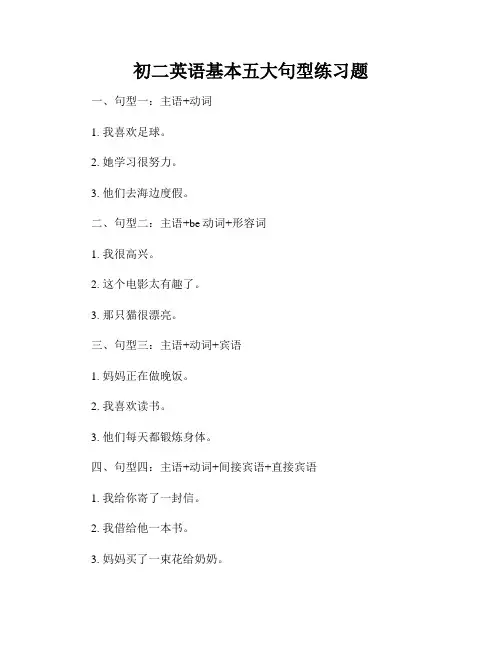
初二英语基本五大句型练习题
一、句型一:主语+动词
1. 我喜欢足球。
2. 她学习很努力。
3. 他们去海边度假。
二、句型二:主语+be动词+形容词
1. 我很高兴。
2. 这个电影太有趣了。
3. 那只猫很漂亮。
三、句型三:主语+动词+宾语
1. 妈妈正在做晚饭。
2. 我喜欢读书。
3. 他们每天都锻炼身体。
四、句型四:主语+动词+间接宾语+直接宾语
1. 我给你寄了一封信。
2. 我借给他一本书。
3. 妈妈买了一束花给奶奶。
五、句型五:主语+动词+宾语+宾语补足语
1. 她使我感到惊讶。
2. 我们看到他们在玩游戏。
3. 这首歌使我想起了过去的回忆。
以上是初二英语基本五大句型的练习题。
通过解答这些练习题,可
以加深对不同句型的理解和掌握,提高英语语法的运用能力。
希望同
学们能够认真完成这些练习,不断巩固所学知识,并能够灵活运用到
日常交流中。
英语学习需要坚持和积累,相信通过不断的练习和努力,大家一定能够取得更好的成绩。
加油!。
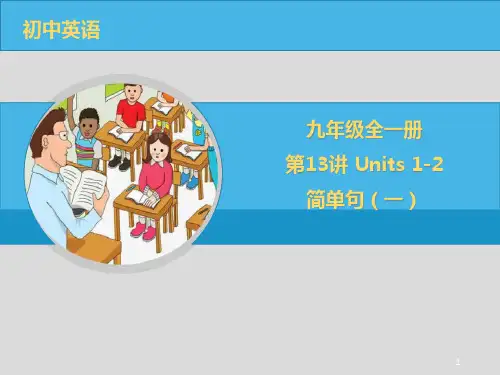
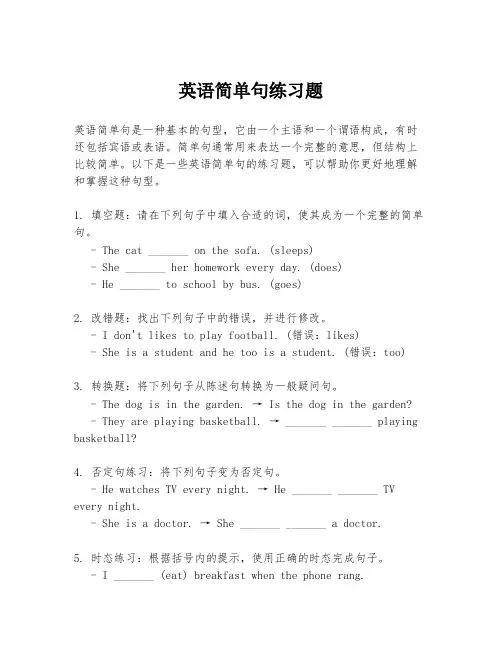
英语简单句练习题英语简单句是一种基本的句型,它由一个主语和一个谓语构成,有时还包括宾语或表语。
简单句通常用来表达一个完整的意思,但结构上比较简单。
以下是一些英语简单句的练习题,可以帮助你更好地理解和掌握这种句型。
1. 填空题:请在下列句子中填入合适的词,使其成为一个完整的简单句。
- The cat _______ on the sofa. (sleeps)- She _______ her homework every day. (does)- He _______ to school by bus. (goes)2. 改错题:找出下列句子中的错误,并进行修改。
- I don't likes to play football. (错误:likes)- She is a student and he too is a student. (错误:too)3. 转换题:将下列句子从陈述句转换为一般疑问句。
- The dog is in the garden. → Is the dog in the garden? - They are playing basketball. → _______ _______ playing basketball?4. 否定句练习:将下列句子变为否定句。
- He watches TV every night. → He _______ _______ TV every night.- She is a doctor. → She _______ _______ a doctor.5. 时态练习:根据括号内的提示,使用正确的时态完成句子。
- I _______ (eat) breakfast when the phone rang.- They _______ (have) a party last night.6. 主谓一致练习:确保下列句子的主语和谓语在数上保持一致。
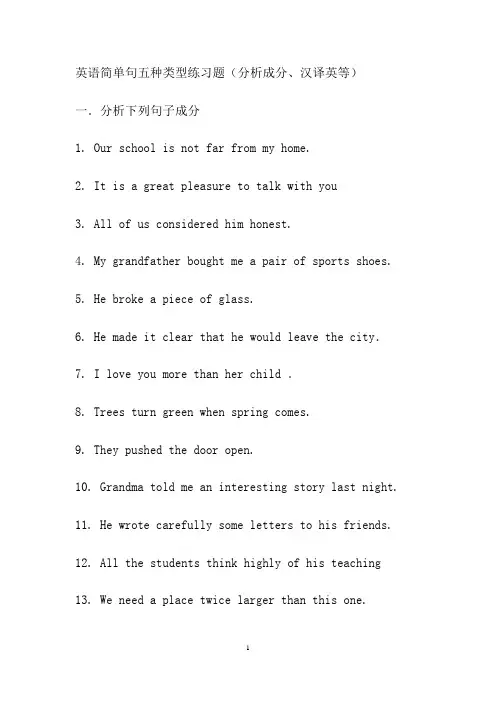
英语简单句五种类型练习题(分析成分、汉译英等)一.分析下列句子成分1. Our school is not far from my home.2. It is a great pleasure to talk with you3. All of us considered him honest.4. My grandfather bought me a pair of sports shoes.5. He broke a piece of glass.6. He made it clear that he would leave the city.7. I love you more than her child .8. Trees turn green when spring comes.9. They pushed the door open.10. Grandma told me an interesting story last night.11. He wrote carefully some letters to his friends.12. All the students think highly of his teaching13. We need a place twice larger than this one.14. He asked us to sing an English song.15. Don't get nervous.16. We will make our school more beautiful.17. He didn't come.That is why he didn't know.18. She showed us her many of her pictures.19. The old man lives a lonely life.20. Luckily the 1989 earthquake did not happen in the center of town.21. The cars made in Japan are better than those in Germany.22. There are so many people in the hall that it's hard for me to find him.23. No matter how difficult the task may be, we must fulfil it this month.24. Go back where you came from.25. We must do whatever the people want us to do.26. At last he got home, tired and hungry.27. Would you please pass me the cup?28 Mary handed her homework to the teacher.29. Do you know the latest news about him?30. I’ll get my hair cut tomorrow.二. 翻译练习:主谓结构(主语+不及物动词)1你应当努力学习。
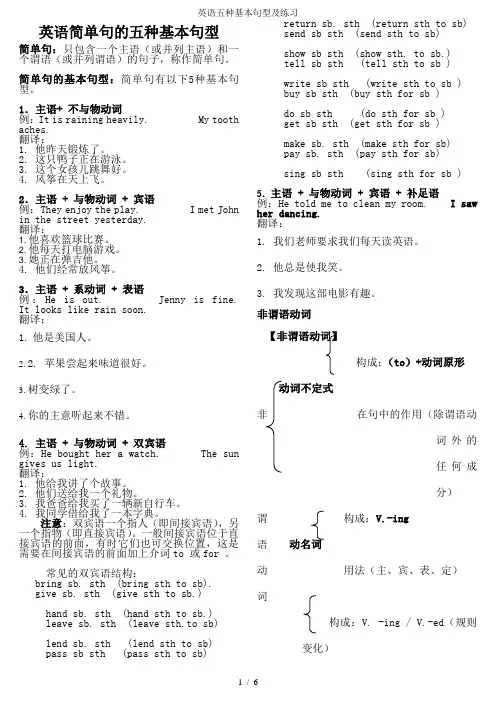
英语简单句的五种基本句型简单句:只包含一个主语(或并列主语)和一个谓语(或并列谓语)的句子,称作简单句。
简单句的基本句型:简单句有以下5种基本句型。
1.主语+ 不与物动词 例:It is raining heavily. My tooth aches. 翻译:1. 他昨天锻炼了。
2. 这只鸭子正在游泳。
3. 这个女孩儿跳舞好。
4. 风筝在天上飞。
2.主语 + 与物动词 + 宾语 例:They enjoy the play. I met John in the street yesterday. 翻译:1. 他喜欢篮球比赛。
2. 他每天打电脑游戏。
3. 她正在弹吉他。
4. 他们经常放风筝。
3.主语 + 系动词 + 表语例:He is out. Jenny is fine. It looks like rain soon.翻译:1. 他是美国人。
2. 2. 苹果尝起来味道很好。
3. 树变绿了。
4. 你的主意听起来不错。
4. 主语 + 与物动词 + 双宾语例:He bought her a watch. The sun gives us light. 翻译:1. 他给我讲了个故事。
2. 他们送给我一个礼物。
3. 我爸爸给我买了一辆新自行车。
4. 我同学借给我了一本字典。
注意:双宾语一个指人(即间接宾语),另一个指物(即直接宾语)。
一般间接宾语位于直接宾语的前面,有时它们也可交换位置,这是需要在间接宾语的前面加上介词to 或for 。
常见的双宾语结构:bring sb. sth (bring sth to sb). give sb. sth (give sth to sb.)hand sb. sth (hand sth to sb.) leave sb. sth (leave sth.to sb) lend sb. sth (lend sth to sb) pass sb sth (pass sth to sb)return sb. sth (return sth to sb) send sb sth (send sth to sb)show sb sth (show sth. to sb.)tell sb sth (tell sth to sb ) write sb sth (write sth to sb ) buy sb sth (buy sth for sb ) do sb sth (do sth for sb ) get sb sth (get sth for sb ) make sb. sth (make sth for sb) pay sb. sth (pay sth for sb)sing sb sth (sing sth for sb )5.主语 + 与物动词 + 宾语 + 补足语例:He told me to clean my room. I saw her dancing. 翻译:1. 我们老师要求我们每天读英语。
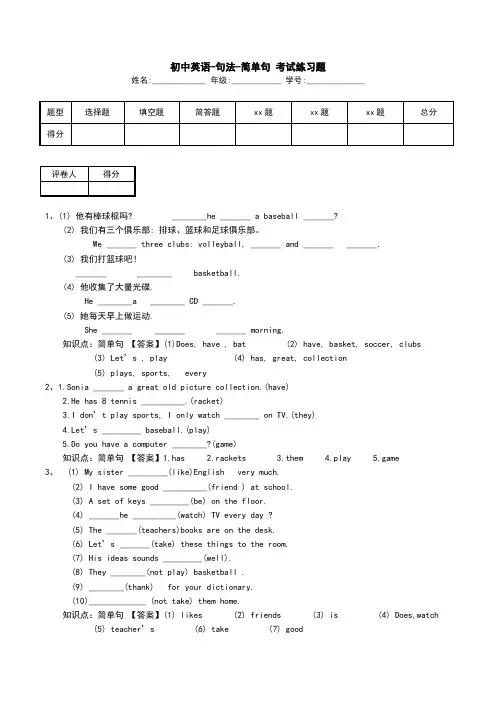
初中英语-句法-简单句 考试练习题姓名:_____________ 年级:____________ 学号:______________1、(1) 他有棒球棍吗? ________he _______ a baseball _______?(2) 我们有三个俱乐部: 排球、篮球和足球俱乐部。
We _______ three clubs: volleyball, _______ and _______ _______.(3) 我们打篮球吧!_______ ________ basketball.(4) 他收集了大量光碟.He ________a ________ CD _______.(5) 她每天早上做运动.She _______ _______ _______ morning.知识点:简单句 【答案】(1)Does, have , bat (2) have, basket, soccer, clubs(3) Let ’s , play (4) has, great, collection(5) plays, sports, every2、1.Sonia _______ a great old picture collection.(have)2.He has 8 tennis __________.(racket)3.I don ’t play sports, I only watch ________ on TV.(they)4.Let ’s _________ baseball.(play)5.Do you have a computer ________?(game)知识点:简单句 【答案】1.has 2.rackets 3.them 4.play5.game3、 (1) My sister _________(like)English very much.(2) I have some good __________(friend ) at school.(3) A set of keys _________(be) on the floor.(4) _______he __________(watch) TV every day ?(5) The _______(teachers)books are on the desk.(6) Let ’s _______(take) these things to the room.(7) His ideas sounds _________(well).(8) They ________(not play) basketball .(9) ________(thank) for your dictionary.(10)_____________ (not take) them home.知识点:简单句 【答案】(1) likes (2) friends (3) is (4) Does,watch(5) teacher ’s (6) take (7) good(8) don’t play (9) Thanks (10) Don’t take4、The teacher’s name is John Brown . His students call him ________ .A、 Mr BrownB、 Mr JohnC、 Mr Herry D. John Brown知识点:简单句【答案】 A5、_______________ ? It’s my ID card.A.What’s that B.Who is thatC.How do you spell that D.Is it an ID card知识点:简单句【答案】 A6、The boy is going to join the basketball team.(改成否定句).The boy _____ _____ to join the basketball team.知识点:简单句【答案】isn’t going【详解】句意:这个男孩要加入篮球队。
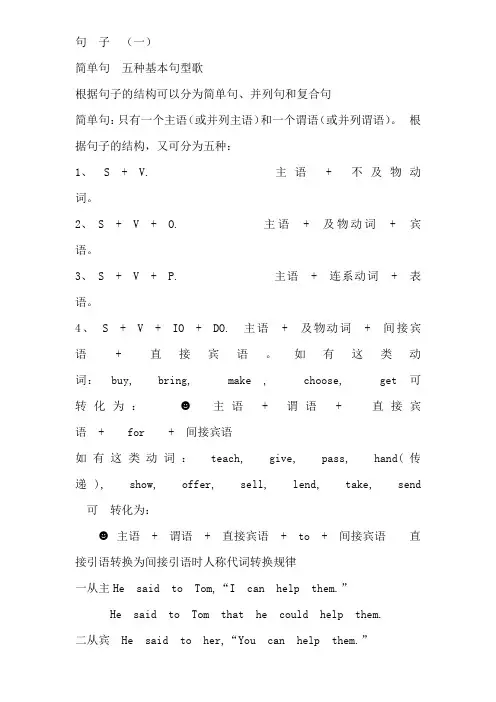
句子(一)简单句五种基本句型歌根据句子的结构可以分为简单句、并列句和复合句简单句:只有一个主语(或并列主语)和一个谓语(或并列谓语)。
根据句子的结构,又可分为五种:1、 S + V. 主语 + 不及物动词。
2、 S + V + O. 主语 + 及物动词 + 宾语。
3、 S + V + P. 主语 + 连系动词 + 表语。
4、 S + V + IO + DO. 主语 + 及物动词 + 间接宾语 + 直接宾语。
如有这类动词: buy, bring, make , choose, get 可转化为:☻主语 + 谓语 + 直接宾语 + for + 间接宾语如有这类动词: teach, give, pass, hand(传递), show, offer, sell, lend, take, send 可转化为:☻主语 + 谓语 + 直接宾语 + to + 间接宾语直接引语转换为间接引语时人称代词转换规律一从主He said to Tom,“I can help them.”He said to Tom that he could help them.二从宾 He said to her,“You can help them.”He told her that she could help them.三不变 He said to Tom,“They can help them.”He told Tom that they could help them.5、S + V + O + C. 主语 + 及物动词 + 宾语 + 宾语补足语。
三、并列句:常由or, but, and, so for等词将两个简单句连接,表示转折,递进等关系。
四、复合句:(Complex Sentence)由一个主句(Principal Clause)和一个或一个以上的从句(Subordinate Clause)构成。
主句是全句的主体,通常可以独立存在;从句则是一个句子成分,不能独立存在。
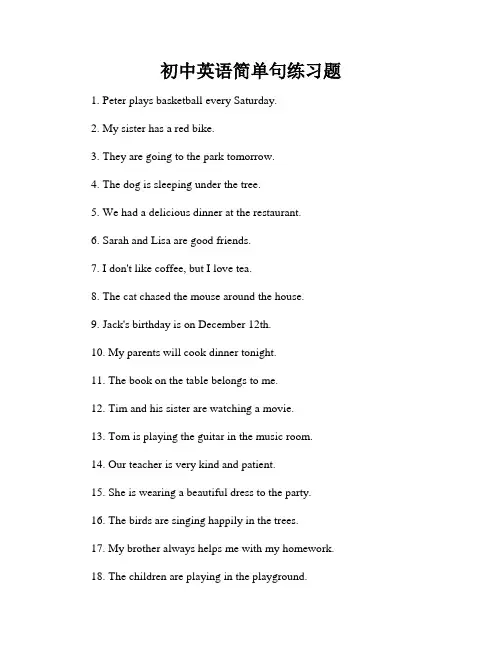
初中英语简单句练习题1. Peter plays basketball every Saturday.2. My sister has a red bike.3. They are going to the park tomorrow.4. The dog is sleeping under the tree.5. We had a delicious dinner at the restaurant.6. Sarah and Lisa are good friends.7. I don't like coffee, but I love tea.8. The cat chased the mouse around the house.9. Jack's birthday is on December 12th.10. My parents will cook dinner tonight.11. The book on the table belongs to me.12. Tim and his sister are watching a movie.13. Tom is playing the guitar in the music room.14. Our teacher is very kind and patient.15. She is wearing a beautiful dress to the party.16. The birds are singing happily in the trees.17. My brother always helps me with my homework.18. The children are playing in the playground.19. I bought a new phone with my pocket money.20. The sun rises in the east and sets in the west.21. We went swimming at the beach yesterday.22. Jane is reading a book in the library.23. The students are studying hard for the exam.24. My grandmother likes to knit sweaters for us.25. Lisa and her cousin are going shopping on Saturday.26. The flowers in the garden are blooming beautifully.27. My dad drives me to school every morning.28. The little boy is crying because he lost his toy.29. I want to learn how to play the piano.30. The weather is getting colder in autumn.31. They visited the museum last week.32. The baby is sleeping peacefully in the crib.33. We are having a picnic in the park today.34. Emma is playing the piano for her friends.35. The students are writing an essay in English class.36. Mark likes to play basketball with his friends.37. The cat is sitting on the chair by the window.38. The dog is barking loudly in the backyard.39. I enjoyed reading the novel during my vacation.40. My parents are cooking dinner in the kitchen.41. The car broke down on the way to the beach.42. Lisa and Tina are swimming in the pool.43. The teacher is explaining the math problem again.44. The boy is riding his bicycle in the park.45. I received a letter from my pen pal in England.46. The students are playing soccer on the field.47. My sister is drawing a picture in her room.48. The bird is singing a beautiful song in the tree.49. We are going to the zoo to see the animals.50. The sun is shining brightly in the sky.51. They are watching a movie at the cinema.52. My brother is playing video games with his friends.53. The baby is laughing at the funny cartoon.54. Emily is dancing ballet on the stage.55. The students are having a field trip to the museum.56. The dog is digging a hole in the backyard.57. My mom is cooking dinner in the kitchen.58. The cat is chasing a butterfly in the garden.59. I am studying for the English test tomorrow.60. The weather is sunny and warm today.以上是初中英语简单句练习题的内容,希望对你有帮助!。
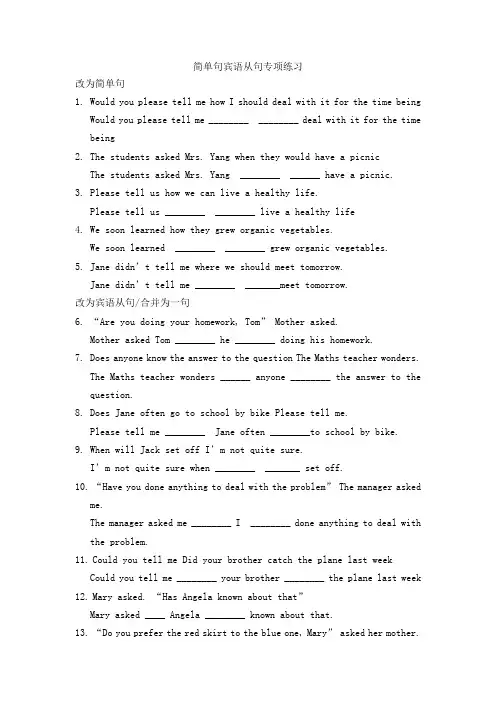
简单句宾语从句专项练习改为简单句1.Would you please tell me how I should deal with it for the time beingWould you please tell me ________ ________ deal with it for the time being2.The students asked Mrs. Yang when they would have a picnicThe students asked Mrs. Yang ________ ______ have a picnic.3.Please tell us how we can live a healthy life.Please tell us ________ ________ live a healthy life4.We soon learned how they grew organic vegetables.We soon learned ________ ________ grew organic vegetables.5.Jane didn’t te ll me where we should meet tomorrow.Jane didn’t tell me ________ _______meet tomorrow.改为宾语从句/合并为一句6.“Are you doing your homework, Tom” Mother asked.Mother asked Tom ________ he ________ doing his homework.7.Does anyone know the answer to the question The Maths teacher wonders.The Maths teacher wonders ______ anyone ________ the answer to the question.8.Does Jane often go to school by bike Please tell me.Please tell me ________ Jane often ________to school by bike.9.When will Jack set off I’m not quite su re.I’m not quite sure when ________ _______ set off.10.“Have you done anything to deal with the problem” The manager askedme.The manager asked me ________ I ________ done anything to deal with the problem.11.Could you tell me Did your brother catch the plane last weekCould you tell me ________ your brother ________ the plane last week 12.Mary asked. “Has Angela known about that”Mary asked ____ Angela ________ known about that.13.“Do you prefer the red skirt to the blue one, Mary” asked her mother.Mary’s moth er asked Mary ________ she ________ the red skirt to the blue one.14.Miss Lin asked Dick ”When will you plan to visit London”Miss Lin asked Dick ________ he ________ plan to visit London.宾语从句选择题1.He asked me ______ during the winter holidays.A. where I had goneB. where I had beenC. where had I goneD. where had I been2.Will you please tell me______A. where Pudong Airport isB. how far Pudong Airport wasC. how can we get to Pudong AirportD. when was PudongAirport built3.I’d like to know ______.A. When will he give back the tapeB. whether has he received higher educationC. that he has been busyD. whether she will join in us4.Professor Nelson wanted to know______.A. when would the conference beginB. when the conference wouldbeginC. when will the conference beginD. when the conference beginwill begin5.Our class teacher asked the monitor______.A. why didn’t Bill come to schoolB. why doesn’t Bill come to schoolC. why Bill didn’t Bill come to schoolD. why Bill doesn’t Bill come t o school6.Do you know ______.A. when will the Beijing Olympic Games endB. when the Beijing Olympic Games will endC. when would the Beijing Olympic Games endD. when the Beijing Olympic Games would end简单句宾语从句专项练习教师版改为简单句1.Would you please tell me how I should deal with it for the time beingWould you please tell me how to deal with it for the time being2.The students asked Mrs. Yang when they would have a picnicThe students asked Mrs. Yang when to have a picnic.3.Please tell us how we can live a healthy life.Please tell us how to live a healthy life4.We soon learned how they grew organic vegetables.We soon learned how to grew organic vegetables.5.Jane didn’t tell me where we should meet tomorrow.Jane didn’t tell me where to meet tomorrow.改为宾语从句/合并为一句6.“Are you doing your homework, Tom” Mother asked.Mother asked Tom if/whether he was doing his homework.7.Does anyone know the answer to the question The maths teacher wonders.The maths teacher wonders if/whether anyone knows the answer to the question.8.Does Jane often go to school by bike Please tell me.Please tell me if/whether Jane often goes to school by bike.9.When will Jack set off I’m not quite sure.I’m not quite sure when Jack will set off.10.“Have you done anything to deal with the problem” The manage r askedme.The manager asked me whether/if I had done anything to deal with the problem.11.Could you tell me Did your brother catch the plane last weekCould you tell me if/whether your brother caught the plane last week 12.Mary asked. “Has Angela known about that”Mary asked if/whether Angela had known about that.13.“Do you prefer the red skirt to the blue one, Mary” asked her mother.Mary’s mother asked Mary if/whether she preferred the red skirt to the blue one.14.Miss Lin asked Dick ”When will you plan to visit London”Miss Lin asked Dick when he would plan to visit London.。
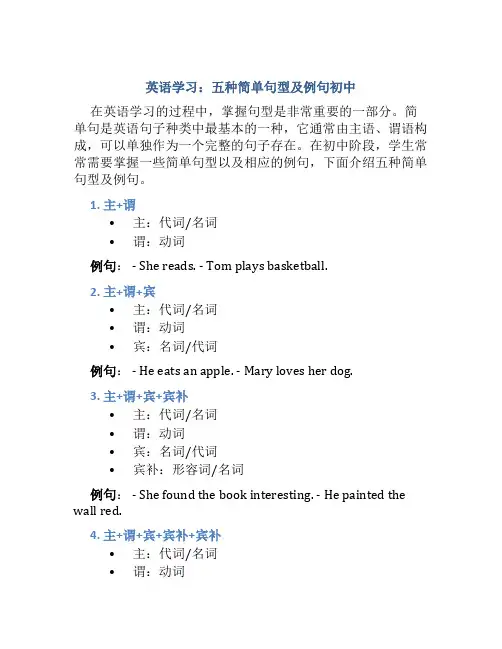
英语学习:五种简单句型及例句初中在英语学习的过程中,掌握句型是非常重要的一部分。
简单句是英语句子种类中最基本的一种,它通常由主语、谓语构成,可以单独作为一个完整的句子存在。
在初中阶段,学生常常需要掌握一些简单句型以及相应的例句,下面介绍五种简单句型及例句。
1. 主+谓•主:代词/名词•谓:动词例句: - She reads. - Tom plays basketball.2. 主+谓+宾•主:代词/名词•谓:动词•宾:名词/代词例句: - He eats an apple. - Mary loves her dog.3. 主+谓+宾+宾补•主:代词/名词•谓:动词•宾:名词/代词•宾补:形容词/名词例句: - She found the book interesting. - He painted the wall red.4. 主+谓+宾+宾补+宾补•主:代词/名词•谓:动词•宾:名词/代词•宾补:形容词/名词•宾补:名词/代词例句: - The teacher considered the question difficult. - I found her answer satisfactory.5. 主+系+表•主:代词/名词•系:连系动词•表:形容词例句: - The flower is beautiful. - He seems happy.以上就是初中英语学习中常见的五种简单句型及例句。
通过不断练习和积累,可以帮助学生更加熟练地运用这些句型,提高英语写作和口语表达能力。
希望同学们在学习中能够不断进步,享受英语学习的过程。
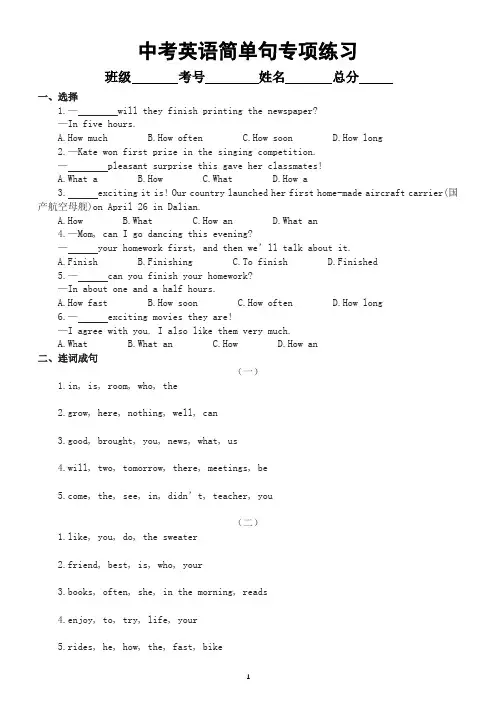
中考英语简单句专项练习班级考号姓名总分一、选择1.—will they finish printing the newspaper?—In five hours.A.How muchB.How oftenC.How soonD.How long2.—Kate won first prize in the singing competition.—pleasant surprise this gave her classmates!A.What aB.HowC.WhatD.How a3. exciting it is! Our country launched her first home-made aircraft carrier(国产航空母舰)on April 26 in Dalian.A.HowB.WhatC.How anD.What an4.—Mom, can I go dancing this evening?—your homework first, and then we’ll talk about it.A.FinishB.FinishingC.To finishD.Finished5.—can you finish your homework?—In about one and a half hours.A.How fastB.How soonC.How oftenD.How long6.—exciting movies they are!—I agree with you. I also like them very much.A.WhatB.What anC.HowD.How an二、连词成句(一)1.in, is, room, who, the2.grow, here, nothing, well, can3.good, brought, you, news, what, us4.will, two, tomorrow, there, meetings, bee, the, se e, in, didn’t, teacher, you(二)1.like, you, do, the sweater2.friend, best, is, who, your3.books, often, she, in the morning, reads4.enjoy, to, try, life, your5.rides, he, how, the, fast, bike(三)1.next week, will, TV, he, watch2.afraid of, Li Gang, talking to, is, strangers3.him, way, to, happened, on, what, the4.too much, in the street, snow, there is5.interesting, it, what, an, is, collection(四)1.a, is, what, nice, he, man2.right, have, answer, found out, the, you3.to, it’s, sho p, cheaper, online, much4.is, your, car, man, who, the, beside5.nothing, leg, there, wrong, is, her, with(五)1.bags, these, yours, are2.for, be, don’t, class, late3.want, do, you, what, be, to4.have, to, needs, she, a, rest, good5.the, a, from, library, book, I, yesterday, borrowed(六)1.you,seen,giraffes,have2.the,they,tallest,are,animals3.to,they,us,friendly,are4.eat,usually,leaves,they,green5.me,can,make friends with,they附:参考答案一、选择1.【答案】C【解析】句意:——他们多久之后将印完这些报纸?——五小时后。
简单句部分1. A library with 5000 books ____ to the school as a gift.A. is offeredB. has offeredC. are offeredD. have offered2. The United States ____ a western country. The Philipines ____ in the Pacific Ocean.A. is; areB. are; isC. is; isD. are; are3. Every means ____ been tried to save the boy.A. hasB. haveC. areD. is4. Mrs Brown as well as her two sisters ____ interested in light music.A. haveB. hasC. areD. is5. A number of the students in our school ____ sent to work in Tibet.A. areB. isC. haveD. has6. The professor and writer ____ coming to make a report on Chinese literature.A. isB. areC. hasD. have7. Many a boy and many a girl ____ made such a funny experiment.A. hareB. areC. hasD. is8. Li Ming ____ his brothers and sisters has a hobby of collecting stamps.A. andB. orC. norD. as well as9. Two hours ____ enough for us.A. areB. haveC. isD. has10. On the table ____ two dictionaries, one open, the other closed.A. liesB. laysC. laidD. lie并列句部分1. --- I don’t like chicken ____ fish.--- I don’t like chicken, ____ I like fish very much.A. and; andB. and; butC. or; butD. or; and2. The bell is ringing _____ the lesson is over.A. butB. orC. andD. yet3. I’m reading a newspaper ______ Mr Zhang is writing a letter.A. soB. whileC. whenD. or4. We have won many victories,______ more difficulties are still ahead of us.A. butB. thereforeC. soD. for5. You have talked much,_____ you haven’t come to the point.A. soB. butC. forD. still6. I must be off now, _____ I’ll be late for the meeting.A. but B. andC. forD. or7. ______ should one help each other._____ he should learn from others.A. Both; andB. Neither; norC. Not only; butD. Either; or8. They can’t drive a car. _____ can I.A. NorB. SoC. ButD. and9. _____ you do it _____ I do it. Anyhow it must be done.A. Neither; norB. Either; orC. Both; andD. Not only; but also10. He is ill in bed,______ we should take care of him.A. soB. butC. eitherD. nor1-5英语简单句、并列句练习题( )1.I help him___ he helps me. We help each other .A. butB. andC. orD. though( ) 2 ___ he ___ I am a doctor.A. Both; andB. Either; norC. Neither; norD. Neither; and( ) 3 Some of us would like to act the story ___ it isn't finished yet.A. butB. andC. thoughD. so( ) 4 One more week, ___ we will finish the task.A. orB. so thatC. andD. if( ) 5 "The ground must be just right ___ too wet ___ too dry.A. either; orB. both; andC. between; andD. neither; nor( ) 6 Sam was ill yesterday, so he________his homework.A. didn'tB. not didC. didn't doD. didn't did( ) 7 Sorry, there's only one seat left. ___ you___ she can have it.A. neither; norB. Either; orC. Both; andD. Not; but ( ) 8 He _________coffee at all. He _________ tea.A. doesn't like, prefersB. likes, doesn't preferC. would like, not prefersD. prefers, is not food of ( ) 9 We _________ happy about the price of meat.A. don'tB. are notC. won'tD. weren't being( ) 10 I ______ trouble finding the place.A. didn't have manyB. haven't a great deal ofC. didn't have muchD. hadn't a lot of( ) 11 _______ of us likes the film.A. BothB. AllC. NeitherD. Some ( ) 12 Which sentence is right?A. I don't think that he is not right.B. I think he is not right.C. I don't think that he is right.D. I think he wasnot right.( ) 13 They are ___ young ___ carry the box onto the table.A. enough; tooB. too; toC. so; toD. very; to( ) 14 They ________ lunch at home every day.A. have notB. didn't haveC. don't haveD. have not any( ) 15--________ is your English teacher like?--He is tall and thin.A. HowB. WhatC. WhichD. / ( ) 16 --_________do you like the new play?--It's good and interesting.A. HowB. WhichC. WhatD. Whom ( ) 17 Pay attention please, ___ of you want to attend the party?A. whoB. whichC. whomD. what ( ) 18 --___ did you sleep last night?--I stayed up too late to go to sleep.A. HowB. WhenC. WhyD. Where ( ) 19 It is getting dark. Our teacher_________.A. lets us to go homeB. lets us go homeC. let us go to homeD. let we go home( ) 20 _________ she sings!A. What beautifulB. How beautifulC. What beautifullyD. How beautifully并列句专题练习并列句单项选择练习1.__________many times,but he still couldn't understand it.A.Having been oldB.Though he had been toldC.He was toldD.Having told2.Tom's mother kept telling him that he should work harder,but__________didn't help.A.heB.whichC.sheD.it3.__________,so Mary was very sad.A.Her mother was very illB.Her mother being illC.Her mother's being illD.Because her mother was ill4.-Sugar__________milk.-Only milk,please,__________I used to like sugar.A.and;andB.and;butC.or;andD.or;but5.It must have rained last night,__________the road is wet.A.whileB.orC.forD.because6.Hurry up,__________we'll miss the train.A.andB.butC.forD.or7.I wrote a letter,__________I forgot to mail it.A.forB.butC.orD.while8.Please__________come in or go out,don't stand there in the doorway. A.neither B.and C.for D.either9.Why was Edison not able to hatch chickens__________the hen could.A.whileB.whenC.becauseD.unless10.The teacher came in,__________the students stood up and said,"Good morning,teacher."A.whileB.andC.butD.for11.__________on the mirror,and you'll find little drops of water on the glass.A.BlowingB.To blowC.BlowD.If you blow12.-I don't like singing__________dancing,what about you.-I don't like dancing,__________I like singing songs.A.and;andB.and;butC.or;butD.or;and13.Good technique in medicine means less pain and fewer deaths and__________,it is our duty to master it.A.altogetherB.thereforeC.otherwiseD.however14.One more word,__________I'll knock you flat.A.soB.andC.butD.therefore15.The car is quite old;__________,there is nothing wrong with it.A.butB.yetC.howeverD.therefore16.I liked this play very much,__________my mother said it was uninteresting.A.andB.forC.soD.but17.-My shirt is torn.-__________me a needle and thread,and I'll mend it for you.A.If you bringB.If you had broughtC.Should you bringD.Bring18.__________to the top of the hill,and you can see the whole of the town.A.To getB.GetC.GettingD.Having got19.Spring is coming;__________gets warmer and warmer,and trees turn green.A.thatB.itC.whichD.as it20.Jack passed all his examinations;__________pleased his parents.A.whoB.itC.which D .all of which参考答案及详解1.and2.Not only;but also3.however4.Neither;nor5.while6.or7.so 8.for 9.Either;or 10.yet 11.but 12.but;and 13.therefore 14.for15.(but) still 16.while 17.and 18.but 19.for 20.or 21.while/but22.however 23.nor 24.yet/but 25.or/otherwise 26.and 27.so/and 28.when参考答案及详解1.C。
初中英语句子专项复习一、简单句简单句是由一个主语和一个谓语构成的句子。
一般情况下,它们可以单独作为一个完整的句子存在。
例句:1. My brother is a doctor.我的兄弟是个医生。
2. They play basketball every afternoon.他们每个下午都打篮球。
二、并列句并列句是由两个或多个主句通过连词连接而组成的句子。
例句:1. I like playing soccer, and my sister likes swimming.我喜欢踢足球,而我妹妹喜欢游泳。
2. He is a good student, but he doesn't like studying.他是一个好学生,但他不喜欢研究。
三、复合句复合句是由一个主句和一个或多个从句组成的句子。
例句:1. We went to the park because the weather was nice.我们去了公园因为天气很好。
2. Jack is going to the party, which starts at 8 o'clock.杰克要去参加晚会,那个晚会八点开始。
四、疑问句疑问句用来询问问题,通常以疑问词或助动词开头。
例句:1. Who is your best friend?你最好的朋友是谁?2. Have you finished your homework?你完成作业了吗?五、祈使句祈使句用来表达请求、命令、建议或劝告,一般省略主语。
例句:1. Open the window, please.请打开窗户。
2. Don't forget to bring your umbrella.别忘记带上你的雨伞。
以上是初中英语句子专项复的内容,希望对你有帮助!。
初中英语简单句练习题### 初中英语简单句练习题一、选择题1. What is your name?- A) My name is John.- B) I am John.- C) John is my name.2. Where are you from?- A) I come from China.- B) China is my country.- C) I am from China.3. What does she like to do?- A) She likes to read books.- B) Reading books is her hobby.- C) She enjoys reading books.4. How old are you?- A) I am thirteen years old.- B) Thirteen is my age.- C) Thirteen years old is me.5. What time is it?- A) It is seven o'clock.- B) Seven o'clock is the time.- C) The time is seven o'clock.二、填空题1. My sister ________ (喜欢) ________ (游泳) in the summer.2. ________ (我们) ________ (去) to school by bus every day.3. The cat ________ (坐在) on the sofa.4. ________ (他) ________ (有) a lot of books.5. ________ (他们) ________ (正在) ________ (学习) English now.三、翻译题1. 我每天早上七点起床。
2. 她正在图书馆看书。
初中英语简单句练习题40题1<背景文章>Tom is a middle school student. He gets up at seven o'clock in the morning. After having breakfast, he goes to school by bike. His school is not far from his home.At school, he has many classes. He likes English and math very much. In English class, he listens to the teacher carefully and takes notes. In math class, he solves problems and discusses with his classmates.After school, he often takes part in after-school activities. Sometimes he plays basketball with his friends. Sometimes he goes to the library to read books.In the evening, he does his homework and reviews what he has learned in the day. Then he watches TV for a while and goes to bed at ten o'clock.1. Tom goes to school ____.A. by busB. by bikeC. on footD. by car答案:B。
解析:文章中提到“After having breakfast, he goes to school by bike.”,所以答案是B。
初中英语简单句单选题40题1. In the classroom, the teacher _____ on the blackboard.A. writesB. writeC. writingD. is write答案:A,本题考查谓语动词的形式。
主语“the teacher”是第三人称单数,在一般现在时中,谓语动词要用第三人称单数形式,A 选项“writes”是正确的;B 选项“write”是动词原形,不符合主语的人称;C 选项“writing”是现在分词,不能单独作谓语;D 选项“is write”语法错误,应该是“is writing”表示正在进行。
2. We often _____ football on the playground after school.A. playB. playsC. playingD. are play答案:A,本题考查一般现在时中谓语动词的形式。
主语“We”是复数,谓语动词用原形,A 选项“play”正确;B 选项“plays”是第三人称单数形式,不符合主语;C 选项“playing”是现在分词,不能单独作谓语;D 选项“are play”语法错误。
3. The students _____ their homework carefully.A. doB. doesC. doingD. is doing答案:A,主语“The students”是复数,一般现在时中谓语用原形,A 选项“do”正确;B 选项“does”是第三人称单数形式;C 选项“doing”是现在分词,不能单独作谓语;D 选项“is doing”是现在进行时,不符合题意。
4. My friend and I _____ to the library every weekend.A. goB. goesC. goingD. are go答案:A,“My friend and I”是复数主语,一般现在时谓语用原形,A 选项“go”正确;B 选项“goes”是第三人称单数形式;C 选项“going”是现在分词;D 选项“are go”语法错误。
初二英语简单句试题1. It takes me two hours my homework every day.A.doing B.to do C.did D.does【答案】B【解析】句意:每天做作业要花我两个小时。
It takes sb. …to do sth.花费某人多长时间做某事。
是一个固定句式,it是形式主语,真正的主语是不定式,故选B。
【考点】考查非谓语动词。
2.Could you __ watch TV? I’m sleeping.A.please don’t B.not please C.please not D.don’t please【答案】C【解析】句意:请你不要看电视好吗?我在睡觉。
could you please do sth ?请做···好吗?否定形式是could you please not do sth ?请不要做···好吗?根据句意,故选C。
【考点】考查固定句式的用法。
3.—I feel stressed out from time to time. Could you give me some advice?— __________ sharing your worries with your parents?A.Why don’t you B.Why notC.How about D.Would you like【答案】C【解析】句意:--我时不时的感到紧张,你能给我一些建议吗?--和你的父母分享你的烦恼怎么样?。
A. Why don’t you+动词原形; B. Why not +动词原形;C. How about +doing ;D. Would you like+to do 都表示征求建议的语气,根据题意和语境可知故选C.【考点】考查动固定句型的用法。
4.—______ a week do you use your computer?—Twice.A.How often B.How soon C.How many times D.How long【答案】C【解析】twice是两次的意思,故就其提问应用how many times。
句子(一)简单句五种基本句型歌根据句子的结构可以分为简单句、并列句和复合句简单句:只有一个主语(或并列主语)和一个谓语(或并列谓语)。
根据句子的结构,又可分为五种:1、 S + V. 主语 + 不及物动词。
2、 S + V + O. 主语 + 及物动词 + 宾语。
3、 S + V + P. 主语 + 连系动词 + 表语。
4、 S + V + IO + DO. 主语 + 及物动词 + 间接宾语 + 直接宾语。
如有这类动词: buy, bring, make , choose, get 可转化为:☻主语 + 谓语 + 直接宾语 + for + 间接宾语如有这类动词: teach, give, pass, hand(传递), show, offer, sell, lend, take, send 可转化为:☻主语 + 谓语 + 直接宾语 + to + 间接宾语直接引语转换为间接引语时人称代词转换规律一从主He said to Tom,“I can help them.”He said to Tom that he could help them.二从宾 He said to her,“You can help them.”He told her that she could help them.三不变 He said to Tom,“They can help them.”He told Tom that they could help them.5、S + V + O + C. 主语 + 及物动词 + 宾语 + 宾语补足语。
三、并列句:常由or, but, and, so for等词将两个简单句连接,表示转折,递进等关系。
四、复合句:(Complex Sentence)由一个主句(Principal Clause)和一个或一个以上的从句(Subordinate Clause)构成。
主句是全句的主体,通常可以独立存在;从句则是一个句子成分,不能独立存在。
从句不能单独成句,但它也有主语部分和谓语部分,就像一个句子一样。
所不同在于,从句须由一个关联词(connective)引导。
复合句(The Complex Sentence):句子中有一个或一个以上的从句,叫做复合句。
复合句可分为:1).定语从句(The Attributive Clause); 2).状语从句(The Adverbial Clause);3).名词性从句(The Noun Clause包括宾语从句、状语从句、定语从句等。
1、宾语从句掌握以下内容: * 引导宾语从句的引导词; * 掌握宾语从句的语序; * 掌握宾语从句的时态一致2、状语从句(1)时间状语从句的连词有:when, while, before, after, until (till), since, as s oon as等。
时间状语从句中通常用一般现在时代替一般将来时。
“主将从现”注意下列几个词的区别:when: *当……的时候指一点时间,表示短暂性动作 *指一段时间,表示持续性的动作 *什么时候引导宾语从句 while: * 表示持续性的动作或状态 * 具有对比的含义, 意为“然而”as: 表示从句的动作与主句的动作同时发生,一般与延续性动词连用. “一边…一边…”随着..As we walked, we talked.As time went by, we knew each other better and better. (2)原因状语从句 because(因为), since(既然), as (由于), for(因为)(3)条件状语从句if(如果) unless(除非)在条件状语从句中,用一般现在时代替一般将来时. 结果状语从句 so + 形容词 / 副词 + that such + 名词 + that… such + a (an) + 形容词+ 名词 = so + 形容词+ a (an) + 名词(5)目的状语从句so that, in order that, (in order to do sth. so as to do sth) (6)比较状语从句as…as… than, not as / so … as…(7)让步状语从句though, although, even though…定语从句:【概念】:修饰名词或代词的从句, 放在名词或代词的后面.名词(人) + who / whom / that + 句子名词(物) + which / that + 句子(1)引导非限制性定语从句时,必须用 which 指物, 不用 that. I have lost my bag, which I like very much. (2)关系代词在从句中做主语时,从句动词的单复数形式和先行词保持一致.Do you know the man who is standing against the door? (3)下列几种情况只能用 that 引导宾语从句:*先行词是不定代词 all, few,little,much,something,nothing, anything等, 如:All that we have to do is to practise more. There is nothing that I can do for you.*先行词被序数词或形容词最高级修饰时,如:The first letter that I got from him is kept well.*先行词被all, any, every, each, few, little, no, some等修饰时,如:I have eaten up all the food that you gave me.(4)由when, where, why 引导的定语从句I don’t know the reason why he was late.This is the place where I have lived for five years.I’ll never forget the day when I met Mr. Li for the first time.先行词是表示地点时,如果从句的动词是及物的,就用that (which), 如果动词不及物,就用where引导.This is the house that he has lived in for five years. This is the house where he has lived for five years.1. C2. B3. D4. C5. D6. C7. B8. D9. D 10. A 11. C 12.A 13.B 14. A15. D 16. D 17. B 18. A 19. B 20. C中考从句专项训练1.(2009·山东)This is the novel _____is written by Guo Jingming.A. whoB. whatC. thatD. /2. (2009·长沙)What are you looking for?—I’m looking for the pen _____I bought yesterday.A. whoB. whichC. whose3. (2009·博) I don’t know the teacher _____ is talking with Miss Wang.A. whatB. whomC. whichD. who4. (2009·济宁) —Have you ever been to the new book shop _____is just opened? —Yes, I went there yesterday.A. /B. whoC. thatD. what5. (2008·襄樊) I like writers _____write short stories.A. whichB. whatC. whomD. who6.Even teachers can’t understand some expressions _____ their students use in daily life.A. whoseB. whoC. thatD. whom7. (2008·芜湖) Beijing is the 29th city ______holds the Olympic Games.A. whereB. thatC. whichD. what8. The clothes ____are in the washing machine are her fathe r’s.A. who B where C. what D. that9. I like movies that _____funny.A. make meB. makes meC. isD. are10. After living in Paris for 20 years, he returned to the small town _____he grew up.A. whereB. thatC. whichD. in that11. I’ll never forget the day ______he came to see me.A. thatB. whichC. whenD. in which12. He remembered nothing ______his mother told him.A. thatB. whatC. whichD. where13. The house _____they live in is large and beautiful.A. whereB. thatC. in whichD. whose14. He talked a lot about the girl and her picture ____inte rested him.A. thatB. whichC. whenD. where15. I think Mrs Smith is the right person _____you should m ake friends.A. whoB. with whoC. whomD. with whom16. —I drove to Dalian for the fashion show last week. —Is that _____you had a few days off?A. whatB. whereC. whenD. why17. You must watch everything _____the teacher does careful ly in the lab.A. ThoseB. /C. whomD. what18. Is there anyone in your class _____family is in the city?A. whoseB. whichC. whomD. who19. He lives in a village _____there are a lot of trees.A. thereB. whereC. thatD. which20. The young lady _____we met yesterday is our new math te acher. A. what B. whose C. whom D. which Keys:。